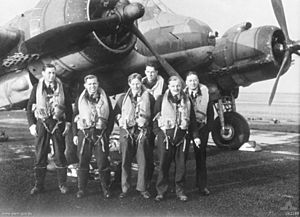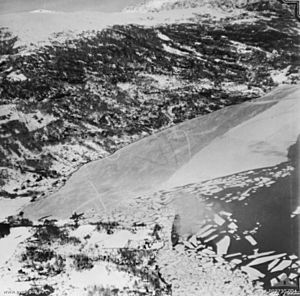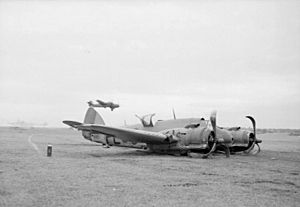Black Friday (1945) facts for kids
Quick facts for kids "Black Friday" raid on Førde Fjord |
|||||||
|---|---|---|---|---|---|---|---|
| Part of the Second World War | |||||||
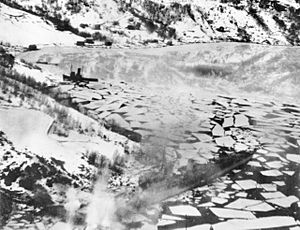 Z33 under attack by Allied aircraft on 9 February 1945 |
|||||||
|
|||||||
| Belligerents | |||||||
| Commanders and leaders | |||||||
| Strength | |||||||
| 31 or 32 Beaufighters 10 or 12 P-51 Mustangs 2 Warwick ASR aircraft |
12 Fw 190s 1 destroyer 3 to 9 escort warships |
||||||
| Casualties and losses | |||||||
| 14 aircrew KIA 4 POW 9 Beaufighters 1 P-51 Mustang |
2 pilots, 7 sailors KIA 4 or 5 Fw 190s |
||||||
On February 9, 1945, a group of Allied Bristol Beaufighter planes faced heavy losses. They were attacking the German destroyer Z33 and its escort ships. The pilots who survived called this day Black Friday.
The German ships were hiding in a very strong defensive spot in Førde Fjord, Norway. This forced the Allied planes to fly through intense anti-aircraft fire, also known as FlaK.
The Beaufighters and their Mustang Mk III fighter escorts from 65 Squadron RAF were met by twelve Focke-Wulf Fw 190s. These German fighters were from Jagdgeschwader 5 (Fighter Wing 5) of the Luftwaffe. The Allied planes managed to damage at least two German ships. However, seven Beaufighters were shot down by FlaK. Two more Beaufighters and a Mustang were shot down by the Fw 190s. In return, the Allied planes shot down four or five German aircraft, including one flown by the famous pilot Rudi Linz.
The decision to attack Z33 instead of nearby merchant ships came from the Admiralty. After the heavy losses, attacking merchant ships became the top priority. Also, another squadron of P-51 Mustangs was sent to protect Allied planes flying near Norway.
Contents
Why Was Norway Important?
By late 1944, Allied victories in France and Eastern Europe meant German ships mostly stayed in the lower Baltic and Norwegian waters. Ports in Norway were Germany's last bases to continue the Battle of the Atlantic. They also used them for trade with Sweden. When the Baltic Sea froze in the winter of 1944–45, Germany had to get its important Swedish iron ore from Narvik in northern Norway.
As German shipping routes through Norway became more vital, the Royal Air Force Coastal Command moved many anti-shipping planes. Seven squadrons moved from eastern England to northern Scotland in late 1944. Three squadrons of Mosquito fighter-bombers were at RAF Banff. A wing of four Beaufighter squadrons was based at RAF Dallachy. These four squadrons were 144 Squadron RAF, 404 Squadron RCAF, 455 Squadron RAAF, and 489 Squadron RNZAF. They had a lot of experience attacking ships over the North Sea.
Attacks by the Banff Wing soon forced German ships to sail at night. During the day, they would hide in deep fjords, which made them very hard to attack. To find German ships, the two wings sent planes on almost daily patrols. These patrols covered the Norwegian coastline from the Skagerrak to Trondheim.
Coastal Command squadrons developed a new tactic. They sent two 'outriders' ahead of the main patrol. These planes had experienced crews. They would fly deep into fjords to find ships that others might miss. By December 1944, patrols were also regularly escorted by RAF Mustang Mk III fighters. Vickers Warwick air-sea rescue planes also joined them. Only one squadron of Mustangs was available. This was because these long-range fighters were needed to protect heavy bombers attacking Germany during the day.
German fighters started appearing off the Norwegian coast in December. By the end of the month, it was common for Allied operations near Norway to be attacked by up to 30 German fighters. In March 1945, the Luftwaffe had many single-engine and twin-engine planes. They operated from ten or twelve airfields south of Trondheim.
Before the Battle
During the first weeks of 1945, Allied strike wings flew few missions. This was due to very bad weather. On January 15, the Banff Wing was attacked by 30 Fw 190 fighters. This happened during a raid on the town of Leirvik. Five Mosquitos and five Fw 190s were shot down.
By February 9, two German fighter units, 9. and 12. Staffeln of JG5, were based at Herdla. This was near Bergen, about 65 miles (105 km) south of Førde Fjord. These units flew Fw 190s. 12. Staffel was led by Leutnant Rudi Linz. He was a 28-year-old flying ace with 69 victories.
The German Narvik-class destroyer Z33 began service in February 1943. She operated in Norwegian waters from July of that year. She was involved in several battles. Z33 was the last German destroyer to leave northern Norway. She sailed for Germany on February 5, 1945. The plan was for Z31 to join her. Z31 had just finished repairs in Bergen after being badly damaged. Together, they would sail to the Baltic Sea.
However, Z33 ran aground in Brufjord on February 7. This damaged her port propeller and caused both engines to fail. She was then towed for repairs in Trondheim. On February 9, Z33 and her two tugboats chose to hide in Førde Fjord during daylight. They were on their way to Trondheim.
The Battle Begins
Finding the Ships
On the morning of February 9, two New Zealand Beaufighters from No. 489 Squadron were patrolling the Norwegian coast. They first saw a 1,500-ton merchant ship in Stong Fjord. As they continued north, they were surprised to find a Narvik-class destroyer. It was with a minesweeper and two flak ships in Førde Fjord. The planes kept patrolling and spotted five large merchant ships in Nord Gulen. They also saw two minesweepers and a flak ship near Bremanger.
Even though the pilots were surprised, Allied command already knew Z33 was in the area. They knew this from secret Ultra intelligence.
The Dallachy Wing was ready to attack any ships found by the reconnaissance patrol. The group of five merchant ships was an easy target. However, Coastal Command was under the Admiralty's orders. The Admiralty had decided to prioritize attacking warships over merchant vessels. So, the wing was sent to attack Z33. This was despite the destroyer and its escorts being well protected in a difficult location for planes to attack.
Wing Commander Jack Davenport planned the attack on Z33. He had commanded No. 455 Squadron before. The plan called for two 'outriders' to fly ahead. They would confirm the German ships' location. Then, the Beaufighters would arrive east of the German anchorage. They would turn west, attack the ships, and escape over the sea. Davenport wanted to keep Allied losses low. But the ships' location in a narrow, protected fjord made the mission very risky.
The strike leader was Wing Commander Colin Milson. He was 25 years old and commanded No. 455 Squadron. Milson was a veteran of many anti-shipping operations. He had fought Italian and German ships in the Mediterranean and North Seas. Milson had doubts about such a costly raid, especially as the war was ending. But he followed the order to attack Z33.
After being spotted, the German ships sailed further up Førde Fjord. They prepared for an Allied attack. Z33 and some escorts anchored close to the steep southern slopes of the fjord. This was near the village of Bjørkedal. Other ships moored near the northern shore. They broke up pack ice with gunfire to make space. This anchorage was also protected by anti-aircraft gun batteries on the fjord's shore.
The Attack Begins
At 1:30 pm on February 9, Milson led 31 or 32 Beaufighters into the air from Dallachy. Ten or twelve P-51 Mustang fighters from 65 Squadron joined the strike force. Two Warwick air-sea rescue planes from 379 Squadron also came along. They carried life rafts to help any aircrew who had to ditch. All four Dallachy Wing squadrons contributed aircraft to the force. The 404 and 455 Squadron Beaufighters carried RP-3 (60lb rockets). The planes from 144 Squadron and 489 Squadron only had their four 20 mm cannon and six machine guns.
After the attackers crossed the Norwegian coast at 3:40 pm, two Beaufighters broke off. They were from 144 and 489 Squadrons and flew ahead as outriders. The outriders flew over Førde Fjord where the German ships had been seen that morning. At 3:50 pm, they radioed Milson. They said they could not see the ships. The 'outriders' then turned east and flew over the town of Førde. They then searched the next fjord to the north. During their flight near Førde Fjord, they did not spot the German warships in their new position. The 9 and 12 Staffeln of JG5 were launched from Herdla at 3:50 pm. They were ordered to attack the Dallachy Wing and its escorts.
Several minutes later, the main group of the raid reached the southern shore of Førde Fjord. They were flying north. To their surprise, the Allied planes flew directly over the German ships. They came under intense fire from anti-aircraft guns. However, no aircraft were hit at this point. Milson turned his force to the right to attack the ships from east to west as planned. But the steep walls of the fjord protected Z33 from attacks from this direction. Milson led the force west to near the mouth of the fjord. He then ordered the Beaufighters to attack one after another, from west to east. This meant the planes had to fly directly into the German defenses. Then they had to escape over steep mountains. The narrow fjord also meant Beaufighters had to attack individually from one direction. They could not overwhelm the German defenses as they usually tried to do.
Milson led the first group of Beaufighters into Førde Fjord around 4:10 pm. His plane escaped undamaged after attacking a flak ship. Other Beaufighters followed him into the fjord. Around this time, 12 Fw 190s arrived at Førde Fjord. They flew through German anti-aircraft fire to intercept the Beaufighters waiting to attack. The British Mustangs were surprised but dived to attack the German fighters. Over 50 aircraft were either in dogfights or diving to attack the German ships. It was the largest air battle ever fought over Norway.
The fight continued until 4:25 pm. By then, the German ships had shot down seven Beaufighters. Fw 190s had claimed two more Beaufighters and a Mustang III. Allied losses included six of the eleven 404 Squadron planes in the attack. The Germans killed 14 Allied airmen and captured four prisoners of war. The Allies damaged Z33 and several other German ships. They also shot down four or five Fw 190s. Linz and another German pilot were killed. Kriegsmarine deaths included four sailors on Z33 and three on the converted trawler VP6808. Both of these ships were damaged during the attack. There may also have been deaths on the other German ships.
After the Battle
After leaving the Førde Fjord area, the surviving Beaufighters, many of them damaged, returned to RAF Dallachy. Several had trouble landing safely. Two made belly landings because their landing gear was damaged. But no more planes were lost. The air and ground crews were shocked by how many planes were lost. The battle became known as "Black Friday". The losses suffered by the Dallachy Wing on February 9 were the highest for any Coastal Command strike wing in one operation during the war.
The German fighters, many low on fuel and ammunition, also broke off around 4:25 pm. They returned to their base. On the night of February 9/10, the German ships left Førde Fjord. They continued their journey to Trondheim. A later Allied attack on the ships by a different strike wing also failed. Z33 arrived in Trondheim on February 11. She was repaired and left for Germany on March 26. She arrived safely at Swinemünde on April 2. She did not see any more combat. She was taken out of service at Brunsbüttel in late April. This was because the Navy did not have enough fuel to operate her.
The losses from the Førde Fjord raid led to changes in how Coastal Command strike wings operated. After the attack, the Admiralty agreed to a plan by Air Chief Marshal Sir Sholto Douglas. He commanded Coastal Command. His idea was to prioritize attacking merchant ships over destroyers and small warships. A second squadron of Mustangs was also moved to protect Coastal Command planes near Norway starting in early March. Milson received a bar to his Distinguished Service Order on July 13, 1945. This was for his leadership and bravery during the Førde Fjord raid. The award described it as a "brilliantly executed operation".
The raid was remembered in Norway after the war. A monument to the aircrew killed in the battle was put up in Førde on May 8, 1985. This was the 40th anniversary of Norway's liberation. This monument was later moved to Bergen Airport. The Air Combat Museum in Naustdal also has photos, maps, aircraft parts, and other items related to the battle.
Surviving Aircraft and Discoveries
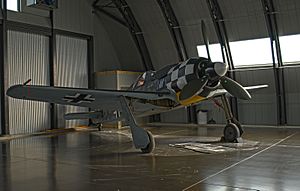
Two of the Fw 190s from JG 5 that fought against the RAF Beaufighters and Mustangs still exist today. One, an F-model with the factory number 931 862, crashed during the "Black Friday" air battles. It was found and recovered in September 1983. This plane is in Stow, Massachusetts. It was being restored by the "White 1 Foundation" in Kissimmee, Florida, to fly again. In 2012, it was moved to the Collings Foundation in Massachusetts to finish the work. While it was still in Florida, in 2005, its last pilot, former Luftwaffe Unteroffizier Heinz Orlowski, visited it. He sat in the cockpit of his Fw 190F-8, about sixty years after he last flew it. He passed away in 2010.
The other surviving Fw 190 is an A-8 model, number 732 183. This was the plane flown by Rudi Linz in the battle. His Fw 190A-8 is displayed in the Cottbus Hangar of the Military Aviation Museum in Pungo, Virginia, United States, as of 2014. The picture in this section shows a replica Fw 190A-8, not Linz's original "Blue 4". However, the museum now has the partially restored original plane (AGO Werks No. 732 183) in this hangar, painted in its correct 12. / JG 5 "Blue 4" colors.
The crash sites of several Beaufighters were found by marine archeologist Rob Rondeau and a diving crew 60 years later. One site received a special plaque. A surviving Canadian airman, Herbert (Bert) Ramsden, who was part of the action, and a sister of an airman who died there, were present.


